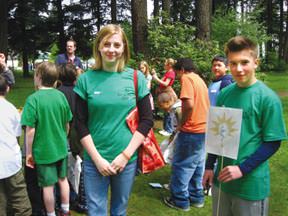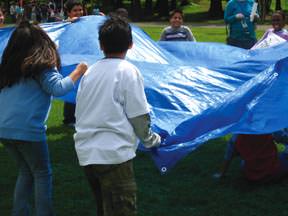 |
||||||||
| MEMO BLOG | Memo Calendar | Memo Pad | Business Memos | Loaves & Fishes | Letters | Home | ||
STEPHANIE MARIE HATCH
FOR THE MID-COUNTY MEMO
 |
| Kaila Murray and Fikret Sacrovic from David Douglas High School help guide fourth-graders to different educational stations Earth Day participants from Lincoln Park Elementary School. At next year's Earth Day event, those same high school students will act as teachers in order to complete their Certificate of Academic Mastery requirements, one route to graduation in Oregon. |
 |
| David Douglas district fourth-graders spend an afternoon at Lincoln Park Elementary School on April 26 learning how to lessen their impact on the environment through a series of activities hosted by DDHS seniors. |
| MEMO PHOTOS: STEPHANIE MARIE HATCH |
DDHS offers eight career pathways that include arts and communication, business management, education and human development, health sciences, hospitality, tourism and recreation, industrial engineering systems, and social and human services. In these programs students explore and master skills that will help them in future educational pursuits or careers. Each program consists of classes that supplement standard high school curriculum.
The career pathways are required for DDHS students in order to complete their Certificate of Academic Mastery. DDHS is one of the last schools in Oregon to require that students enroll in a CAM program. CAM was created for Oregon schools over a decade ago, but it is no longer required due to its unpopularity. This unpopularity stems from the basis that the test only measures Oregon students against other Oregon students, and it is not viable in the job market or college admission processes. However, the CAM program is the catalyst for the Earth Day activities organized by natural resources career pathway students and proves to have some positive effects.
After months of planning, the annual Earth Day event was hosted by DDHS seniors. David Douglas district fourth-graders were invited to this educational celebration. Booths covered topics such as recycling, watersheds, electric cars, waste-less lunches, botany and art.
Fourth-graders started off the day by listening to a reading of “The Lorax,” written by Dr. Seuss and published in 1971. “The Lorax” is a parable about the consumption of natural resources by industrialized society. Its political message caught many people off guard at the time it was published and made it highly controversial. However, such a story has renewed importance at a time when global warming is on everybody’s mind. The whole point of this event was to raise children’s awareness of their impact on the environment, and the reading of “The Lorax” got them into the right mindset.
Jace Craun and Martha Hale, DDHS seniors, relaxed under a tent during the reading, waiting to teach the younger students how to separate recyclables from trash. After completing the activity in a fun, relay-style game, the kids were able to realize that they wouldn’t produce much trash if they recycled all they could.
When asked why he chose the natural resources program, Craun replied that he had an interest in plants, nature and the environment. He admitted that it felt a bit contradictory for him to be in the natural resources program, though. He plans to go into construction after high school and recognizes that the field can consume a lot of resources and be harmful to the environment. Luckily, the natural resources program has encouraged him to think more about green building so he can work in a way that will be more conscious of the environment and of conserving resources.
“There’re many ways to better this Earth...like being a good role model for these kids,” Craun said. He emphasized that it’s important to teach kids to take care of the earth before they develop destructive habits.
Different students had equally different reasons for joining the natural resources career pathway.
Lindsay Fung, a DDHS junior, stood by her group of fourth-graders at the waste-less lunch booth, taught by Freda Sherburne from Metro. The kids learned how to pack a lunch using reusable containers so as to reduce waste and how to identify compostable foods and recyclable wrappers.
Keeping an eye on her group, Fung said she chose the natural resources career pathway because she really loves animals. She plans on becoming a zoologist after high school.
DDHS junior Kaila Murray said she chose the natural resources career pathway because she loves spending time outdoors. Murray intends to study marine biology in college. As a junior, Murray was a group guide for this event, helping to move the rambunctious groups of kids from booth to booth every 14 minutes.
Murray said that being a group guide was practice for her because next year she will be one of the organizers and teachers. This year Murray and her fellow junior classmates organized Eco-Adventure, a series of ecological tutorials for district third-graders. Eco-Adventure was held on the DDHS campus and took place over the course of several days. Murray and other juniors earned their Certificate of Initial Mastery by organizing and participating in the event. CIM is one level before CAM.
An offshoot of the natural resources career pathway is Earth Club, an after-school program headed by Stacy Barber, head of the junior natural resources students. Earth Club is in its first year but has already managed to organize a presentation for Arbor Day that was held at Forest Park. Members also sold Earth Day T-shirts at Ventura Park Elementary School during another Earth Day celebration. Barber is enthusiastic about her students and has invested time and interest in their futures through this career pathway program.
Barber toured the Earth Day activities and helped cultivate conversations about what the students had learned. Quizzing the kids on recycling habits, Barber handed out high fives to those who piped up with earth-friendly answers. She said the hope and intention of the event was to teach the children how to lessen their impact on the environment and learn the meaning of sustainability.
Like the flurry of booth rotations at the Earth Day event, the world in which these students are growing up is changing rapidly. A supportive team of counselors and teachers help DDHS students find direction in the whirlwind of transitioning from high school to the world beyond. “Students in the natural resources career pathway are learning how to build a future balanced between environmental consciousness and their personal passions”
 |
 |
 |
MEMO Advertising | MEMO Archives | MEMO Web Neighbors | MEMO Staff | Home